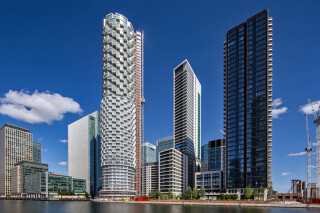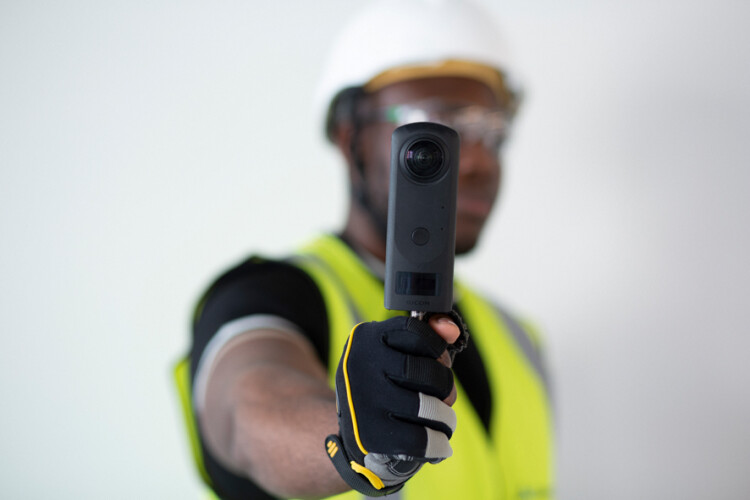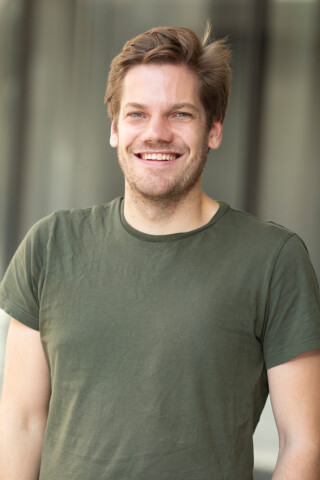Popping out of the site office to check a detail isn’t a two-minute job when the building you’re working on is tens of storeys high.
The need to tog up in PPE and wait for a hoist – and no doubt get caught up in other things – means that dealing with even a simple query can easily eat up an hour or more. Taken over a week, the time spent digging out routine information can make a big dent in productivity. Canary Wharf Contractors (CWC) has tackled the issue by introducing an artificial intelligence (AI) system that has freed up surprisingly large amounts of time that can be spent on more useful things.
Two years ago, CWC teamed up with specialist tech firm Disperse to transform its approach to construction delivery. The two have worked closely together to develop and refine Disperse’s core building productivity management system through use on the interiors work for a portfolio of major buildings on the Canary Wharf Estate in London. At the heart of the initiative has been a desire to free teams from routine admin chores and eliminate endless manual searching for information, enabling them to focus on the work itself, drive progress, solve problems and manage the people on site.
This article was first published in the Dec/Jan 2021 issue of The Construction Index magazine. Sign up online.
The system’s 360o cameras scan the site every week to create an interactive digital twin of the building. Disperse uses AI to process the visual data so that progress can be tracked and action taken.
The towers feature a great deal of repetition – the tallest has 57 residential floors, with one floor looking much like another – and so the cameras and the AI are proving very helpful. “You’ve suddenly got another set of eyes,” says Tony Lonergan, head of planning at CWC. “If you are working on a 34-floor building – and working on similar trades on 15 of those floors – it is very difficult to differentiate between one floor and another.”
Clear and immediate benefits were achieved, right from the early days when an initial win was the use of the 360o cameras to collect weekly photos and tie them reliably to the correct location. Additional functions have since been added but it is only recently that CWC has quantified the time that is saved on a typical project. The figures have come from the construction managers and planners themselves. “They provided feedback on how much time they saved – roughly how many hours a week,” says Roman Baran, project manager of system development at CWC. Reviewing field examples since 2018, it turned out that using the system has saved a typical construction manager 26 hours a week, a 65% saving. Other savings are 18 hours for a planner, while both project managers and project directors save around 12 hours a week.
A particular saving for the construction managers has been in taking photos. Another is that, while having to leave the site office to check on something can take an hour or more if it involves putting on PPE and waiting for a site hoist to travel up a couple of dozen floors, many such queries can now be readily checked on screen.
CWC says that the savings it has experienced have been conservatively estimated at 25 times Disperse’s fees across a portfolio of five buildings since 2018.
“We’re a commercial business – if we are going to invest in a project, we need to get back more than we invest,” says Lonergan. But how you value that is quite a challenge. “We’ve tried to measure it in terms of productivity.” Other benefits come is resolving issues with any trade contractors when there have been disagreements. The system gives the ability to look back at every area and see exactly where things stood at the time in question.
Disperse’s system is not designed to do everything: both the developer and the client have taken pains to keep the wish list realistic and avoid adding lots of over-complex features that would likely take more time to set up than they would save.
CWC started using the system in 2018 with buildings E1 and E2, which together contain over 200 apartments. “That’s where we tested the system,” says Baran. “When we were happy with it we moved on and we added other buildings.” E1 and E2 have since been completed – on time – and the other buildings that have steadily followed include the biggest of them all. Newfoundland, which is now being finished, has 636 apartments across 57 residential floors in a 67-storey building close to the River Thames. Work on a further building - a hotel and office - is getting under way and will be the ninth project to use the system.
Disperse has chosen to work hand in hand with construction companies such as CWC to ensure that the data generated will work with existing workflows. When it first approached CWC a few years ago, the company found it was pushing at an open door: “We wanted to be more proactive in our approach – which means spending less time collecting data and more time acting on it,” says Lonergan. “We knew what we needed but what we didn’t recognise was how we could get there.” Disperse had a good understanding of how to get there but needed somebody who wanted to make it work.
"What we are taking away is the need to spend hours and hours walking the site with a clipboard,” says Felix Neufeld, CEO and co-founder of Disperse. Dispensing with this gives the managers time that can be spent more productively, for instance talking with the trade contractors. "The key thing we are aiming to accomplish as a company is gradually improving the productivity of the construction industry,” he says.
“We obviously started with a raw idea and it’s now something far more refined,” says Lonergan. “On every project, we have champions who collect feedback from the users.” Views are reported back and have led to the development of further features.
This article was first published in the Dec/Jan 2021 issue of The Construction Index magazine. Sign up online.
The digital twin captured by Disperse’s system is analysed by computer vision technology to measure progress and identify potential issues, backed up by a navigable visual record of the work. The reports that are produced have been designed to integrate into existing management tools and to highlight early warnings where a project may derail.

Disperse had originally looked at other types of project, including superstructure work, but discussions with CWC shifted the focus to residential projects with extensive interior works.
“We were at pains to limit what we were trying to achieve so that we weren’t trying to do things that we were already doing well and that were straightforward,” says Lonergan. For instance, there had been an early discussion about use in connection with cladding installation. “My view is that I can get anyone to count 15 cladding panels,” he says. "We’re not really going to get a return on investment unless it’s for something complicated."
This led to the focus on interiors. Historically, it has been time-consuming to capture regular and consistent data, particularly on projects with the same activities taking place on multiple floors. Such work is difficult to keep track of, particularly as there is considerable interaction between trades.
"Our construction managers and project managers, with the best of intentions, will probably get half-way up the building and get distracted five times on the way and never get to the end of the exercise,” says Lonergan. “We looked at how we could manage that. We also drove the idea of tying together the programme and the narrative of how we were going to build it. What we found through some of the early exercises was that there was a misunderstanding between our own planning teams and our construction teams and Disperse as to what an activity contained."
Meetings were set up to address this by going through every activity; the few hours it took were well spent. The exercise involved breaking down the activities in the programme and the components involved in items like ‘drywall first fix’. It brought benefits for everyone, Baran found, and as it clarified where people had been seeing things differently. Information is extracted from the images and the data is readily available; people can sit down with the different stakeholders and discuss the findings. Screenshots can, for instance, warn that something isn’t yet finished but will soon be covered up and hence inaccessible.
About 140 people from CWC are using the system, which is used for cost management as well as by the construction teams. This proved particularly useful during lockdown, says Lonergan: "I had many requests from cost managers asking to gain access to the system because they couldn’t go to site. They could look into the system and see what had been done – or what hadn’t."
He adds: "By being focused on ‘where should we be?’ as opposed to ‘where are we?’ and doing that comparison it means we are far more accountable to time and where we promised ourselves in the programme that we would be. We’re really trying to simplify the process. It helps put the focus on asking the right questions."
Use on hundreds of residential units has allowed the system to be refined and streamlined. But there is no desire for the AI’s workload to keep on growing just for the sake of it; automation is used only where it is appropriate. “There is always a human element,” says Neufeld. Machines are really good at dealing with data and processing information, particularly when there are thousands of data points – as with the basic components within a building. But when it comes to more nuanced matters – such as components that are harder to differentiate on a purely visual basis – humans can be much more effective than machines.
That is not the only consideration. Construction teams need to get on with the project – not be burdened with helping get the kinks out of the software. "This is why Disperse is not afraid of having people involved in the business," he says. "We want to provide the best solution for the site team."
Lonergan has found that one of the major roadblocks for many innovations is the ability to get traction. "People are generally very busy and they see anything additional as more work," he says. "Even if in the long term they might believe that it will give them something better, it’s still hard to convince them to put the time in at the front." CWC has worked very hard to overcome this with the Disperse system. "We rolled it out on a single project and spent a lot of time working with the construction teams, convincing them of the benefits and how it saves them time because they don’t have to do certain functions," he says. Once they’d realised that the data would be taken from the camera, they were then on board straightaway.
Information has to be easy to digest. "Everyone has got 30 seconds – if they have to go beyond that they’ll lose interest," he adds. The aim is to present good quality information in a simple manner in such a way that, if you need more detail, you can drive down into it.
The reason that the development of the system by CWC and Disperse has worked so well, says Baran, is that "we mix our experience of construction and systems and IT". There was never any question of simply leaving Disperse to get on with the deployment. "They learnt from us and we learnt from them," he says.
"One of the big strengths that they had was their size," says Lonergan – by which he means small. "We could work very closely together to develop a strong product." Other companies that have since come on board with Disperse’s system have gained the benefit of that, he says. Equally CWC has benefitted from the questions that others have asked. The heart of the system remains the same for each client, but inputs and outputs do vary to some extent, says Neufeld.
There have been instances where CWC asked for things that have been very difficult for the software to do – but that were important enough to implement. In other cases, it soon became apparent that the effort involved could never justify the return and so the idea was dropped.
The project’s drawings and the BIM model are used but the system isn’t yet at the stage of working with full-depth BIM models. Over time, the hope is to unlock more of the value of the BIM models, but the reality is that the industry isn’t yet at this stage, Neufeld says. He believes that it would be a mistake to start from the point of what is technically possible and create a technically optimal solution designed for an ideal scenario. "If you really want to provide value, you need to be realistic and pragmatic," he says.
Development continues. "We’re always looking to improve it to make it better,” says Baran. "The construction environment is always changing and we are adapting with it."
This article was first published in the Dec/Jan 2021 issue of The Construction Index magazine. Sign up online.

Got a story? Email news@theconstructionindex.co.uk




